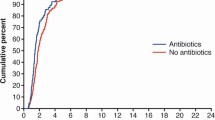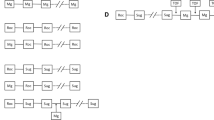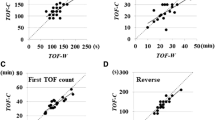Abstract
Purpose
There is no report investigating the precise potency of sugammadex for antagonizing various intensities of rocuronium-induced neuromuscular block. The aim of this study was to evaluate the ED95 of reversibility of sugammadex and reveal the safety factor of 2 mg/kg of sugammadex for moderate rocuronium-induced neuromuscular block.
Methods
Fifteen patients were enrolled in this study. After induction of anesthesia, we recorded the adductor pollicis muscle response to ulnar nerve stimulation using acceleromyography. All patients received 0.6 mg/kg rocuronium. When the first twitch (T1) of the train-of-four (TOF) response reappeared, rocuronium infusion was commenced to maintain T1 at 10% of the control. After the surgery was completed and infusion of rocuronium was stopped, patients were given sugammadex by a cumulative dose technique. The effective doses of sugammadex that led to recovery of the amplitude of T1 and the TOF ratio by 95% (ED95) were calculated from the regression lines of least-squares regression analysis.
Results
The mean ED95 of sugammadex for recovery of T1 and the TOF ratio from rocuronium-induced moderate neuromuscular block was 1.34 (0.24) and 1.14 (0.24) mg/kg, respectively.
Conclusions
The ED95 of sugammadex for the recovery of T1 was significantly greater than that for the TOF ratio. However, a sugammadex dose of 2 mg/kg is equivalent to about 1.5 times the ED95 of sugammadex for reversal of moderate rocuronium-induced block, indicating its safety margin.


Similar content being viewed by others
References
Puhringer FK, Gordon M, Demeyer I, Sparr HJ, Ingimarsson J, Klarin B, van Duijnhoven W, Heeringa M. Sugammadex rapidly reverses moderate rocuronium- or vecuronium- induced neuromuscular block during sevoflurane anaesthesia: a dose-response relationship. Br J Anaesth. 2010;105:610–9.
Duvaldestin P, Kuizenga K, Saldien V, Claudius C, Servin F, Klein J, Debaene B, Heeringa M. A randomized, dose-response study of sugammadex given for the reversal of deep rocuronium- or vecuronium-induced neuromuscular blockade under sevoflurane anesthesia. Anesth Analg. 2010;110:74–82.
Fuchs-Buder T, Claudius C, Skovgaard LT, Eriksson LI, Mirakhur RK, Viby-Mogensen J. Good clinical research practice in pharmacodynamics studies of neuromuscular blocking agents II: the Stockholm revision. Acta Anaesthesiol Scand. 2007;51:789–808.
Suzuki T, Fukano N, Kitajima O, Saeki S, Ogawa S. Normalization of acceleromyographic train-of-four ratio by baseline value for detecting residual neuromuscular block. Br J Anaesth. 2006;96:44–7.
Kopman AF, Lien CA, Naguib M. Neuromuscular dose-response studies: determining sample size. Br J Anaesth. 2011;106:194–8.
Nemes R, Fülesdi B, Pongrácz A, Asztalos L, Szabó-Maák Z, Lengyel S, Tassonyi E. Impact of reversal strategies on the incidence of postoperative residual paralysis after rocuronium relaxation without neuromuscular monitoring. A partially randomized placebo controlled trial. Eur J Anaesthesiol. 2017;34:609–16.
Kotake Y, Ochiai R, Suzuki T, Ogawa S, Takagi S, Ozaki M, Nakatsuka I, Takeda J. Reversal with sugammadex in the absence of monitoring did not preclude residual neuromuscular block. Anesth Analg. 2013;117:545–51.
Muramatsu T, Isono S, Ishikawa T, Nozaki-Taguchi N, Okazaki J, Kitamura Y, Murakami N, Sato Y. Differences of recovery from rocuronium-induced deep paralysis in response to small doses of sugammadex between elderly and nonelderly patients. Anesthesiology. 2018;129:901–11.
Matsui M, Konishi J, Suzuki T, Sekijima C, Miyazawa N, Yamamoto S. Reversibility of rocuronium-induced deep neuromuscular block with sugammadex in infants and children—a randomized study. Biol Pharm Bull. 2019;42:1637–40.
Ito S, Seki H, Sannohe J, Ouchi T. A case of deep residual neuromuscular blockade after sugammadex administration. J Clin Anesth. 2019;58:33–4.
Suzuki T. A train-of-four ratio of 0.9 may not certify adequate recovery after sugammadex. Acta Anaesthesiol Scand. 2011;55:368–9.
Jonsson M, Gurley D, Dabrowski M, Larsson O, Johnson EC, Eriksson LI. Distinct pharmacologic properties of neuromuscular blocking agents on human neuronal nicotinic acetylcholine receptors. A possible explanation for the train-of-four fade. Anesthesiology. 2006;105:521–33.
Smith CE, Donati F, Bevan DR. Dose-response curves for succinylcholine: single versus cumulative techniques. Anesthesiology. 1988;69:338–42.
Gibson FM, Mirakhur RK, Clarke RSJ, Lavery GG. Comparison of cumulative and single bolus dose techniques for determining the potency of vecuronium. Br J Anaesth. 1985;57:1060–2.
Claudius C, Skovgaard LT, Viby-Mogensen J. Is the performance of acceleromyography improved with preload and normalization? A comparison with mechanomyography. Anesthesiology. 2009;110:1261–70.
Kopman AF, Chin W, Cyriac J. Acceleromyography vs. electromyography: an ipsilateral comparison of the indirectly evoked neuromuscular response to train-of-four stimulation. Acta Anaesthesiol Scand. 2005;49:316–22.
Acknowledgements
Osamu Kitajima and Mai Yamamoto are equally contributing first authors of this article.
Funding
Departmental funding.
Author information
Authors and Affiliations
Corresponding author
Ethics declarations
Conflict of interests
Suzuki T and Takagi S have received speaker’s fee from MSD. Inc, Japan.
Additional information
Publisher's Note
Springer Nature remains neutral with regard to jurisdictional claims in published maps and institutional affiliations.
About this article
Cite this article
Kitajima, O., Yamamoto, M., Takagi, S. et al. Potency estimation of sugammadex for the reversal of moderate rocuronium-induced neuromuscular block: a non-randomized dose–response study. J Anesth 34, 348–351 (2020). https://doi.org/10.1007/s00540-020-02751-5
Received:
Accepted:
Published:
Issue Date:
DOI: https://doi.org/10.1007/s00540-020-02751-5




